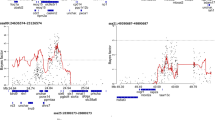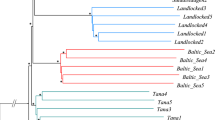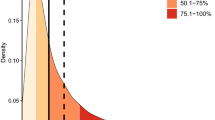Abstract
This study aimed to increase the number of allozyme loci which may be screened in the Atlantic salmon, Salmo salar L., particularly for use in investigating interactions between wild populations and reared strains. Three samples of wild salmon from Ireland, Scotland and Spain and one from a farmed strain of Norwegian origin were used as index samples. Other Irish samples were used in technique development. Ninety-one enzyme loci were resolved, including 21 not previously screened in S. salar. Thirteen loci were found to be variable, including three novel polymorphic loci (EST-5*, FBALD-3* and TPI-3*). Two novel alleles (sAAT-1,2*130 and sAAT-3*83) were also detected. Levels of variability were lowest in the Spanish sample. The farmed strain had levels of H̄ and P̄ lower than those in the two other wild samples. Mean levels of H̄ and P̄ were higher than those reported previously in studies that used a smaller number of loci but confirm S. salar as one of the less variable salmonids. Nine of the 13 variable loci showed significant population differentiation, the most discriminatory being mMEP-2*. The discriminatory power of the novel variable loci was in the middle of the range of those of the other loci. D̄ values reflected the relative geographical locations from which the samples originated. There were significant clines in allele frequencies at mMEP-2* and TPI-3*. Fourteen enzyme loci including six variable loci were resolved in adipose fin.
Similar content being viewed by others
Article PDF
References
Aebersold, P B, Winans, G A, Teel, D J, Milner, G B, and Utter, F M. 1987. Manual for Starch Gel Electrophoresis: Complete Procedures for Detection of Genetic Variation. U. S. Department of Commerce, NOAA Technical report NMFS, no. 61. Seattle, WA.
Allendorf, F, Knudsen, K L, and Phelps, S R. 1982. Identification of a gene regulating the tissue expression of a phosphoglucomutase locus in rainbow trout. Genetics, 102, 259–268.
Black, W C, and Krafsur, E S. 1985. A FORTRAN program for the calculation and analysis of two-locus linkage disequilibrium coefficients. Theor Appl Genet, 70, 491–496.
Blanco, G, Sánchez, J A, Vázquez, E, Rubio, J, and Utter, F M. 1992. Genetic differentiation among natural European populations of Atlantic salmon, Salmo salar L., from drainages of the Atlantic Ocean. Anim Genet, 23, 11–18.
Campton, D. 1987. Natural hybridisation and introgression in fishes: methods of detection and genetics interpretations. In: Ryman, N. and Utter, F. (eds) Population Genetics and Fishery Management, pp. 161–192. University of Washington Press, Seattle.
Clayton, J W, and Tretiak, D N. 1972. Amine-citrate buffers for ph control in starch gel electrophoresis. J Fish Res Board Can, 29, 1169–1172.
Cross, T F. 1991. Potential genetic interactions between reared and wild fish in Europe, with particular emphasis on Atlantic salmon. In: De Pauw, N. and Joyce, J. (eds) Aquaculture and the Environment, pp. 299–308. European Aquaculture Society Special Publication no. 16 Gant, Belgium.
Cross, T F, and Payne, R H. 1977. NADP-isocitrate dehydrogenase polymorphism in the Atlantic salmon Salmo salar. J Fish Biol, 11, 493–496.
Cross, T F, and Ward, R D. 1980. Protein variation and duplicate loci in the Atlantic salmon, Salmo salar L. Genet Res, 36, 147–165.
Cross, T F, Ward, R D, and Abreu-Grobois, A. 1979. Duplicate loci and allelic variation for mitochondrial malic enzyme in the Atlantic salmon, Salmo salar L. Comp Biochem Physiol, 62B, 403–406.
Elo, K, Vuorinen, J A, and Niemelä, E. 1994. Genetic resources of Atlantic salmon (Salmo salar L.) in Teno and Näätämö Rivers, northernmost Europe. Hereditas, 120, 19–28.
Ferguson, A. 1980. Biochemical Systematics and Evolution. Blackie, Glasgow.
Garcia De Leániz, C, Verspoor, E, and Hawkins, A D. 1989. Genetic determination of the contribution of stocked and wild Atlantic salmon, Salmo salar L., to the angling fisheries in two Spanish rivers. J Fish Biol, 35 (Suppl. A), 261–270.
Hillis, D M, and Moritz, C. 1990. Molecular Systematics. Sinauer Associates, Sunderland, MA.
Hindar, K, Ryman, N, and Utter, F. 1991. Genetic effects of aquaculture on natural fish populations. Can J Fish Aquat Sci, 48, 945–957.
Holmes, R S, and Masters, C J. 1970. Epigenetic inter-conversions of the multiple forms of mouse liver cata-lase. FEBS Lett, 11, 45–48.
Johnson, K. 1984. Protein Variation in the Salmoninae: Genetic Interpretations of Electrophoretic Banding Patterns, Linkage Associations Among Loci, and Evolutionary Relationships Among Species. Ph.D. Thesis, Pennsylvania State University.
Jordan, W C. 1990. Gene Flow Among Atlantic Salmon (Salmo salar) Populations in Scotland. Ph. D. Thesis, The Queen's University of Belfast, Northern Ireland.
Kazakov, R V, and Titov, S F. 1991. Geographical patterns in the population genetics of Atlantic salmon, Salmo salar L., on U.S.S.R. territory, as evidence for colonization routes. J Fish Biol, 39, 1–6.
Khanna, N D, Juneja, R K, Larsson, B, and Gähne, B. 1975a. Electrophoretic studies on proteins and enzymes in the Atlantic salmon, Salmo salar, L. Swedish J Agric Res, 5, 185–192.
Khanna, N D, Juneja, R K, Larsson, B, and Gähne, B. 1975b. Electrophoretic studies on esterases in the Atlantic salmon, Salmo salar, L. Swedish J Agric Res, 5, 193–197.
Lewontin, R C, and Krakauer, J. 1973. Distribution of gene frequency as a test of the theory of the selective neutrality of polymorphisms. Genetics, 74, 175–195.
McElligott, E A. 1987. A Genetic Investigation of the Population Structure of Wild and Hatchery Reared Atlantic Salmon (Salmo salar L.) in Ireland. M.Sc. Thesis, University College Cork, Ireland.
Maitland, P S. 1989. The Genetic Impact of Farmed Atlantic Salmon on Wild Populations. Nature Conservancy Council, Edinburgh.
Moffett, I J J, and Crozier, W W. 1991. Genetic marker identification in Atlantic salmon (Salmo salar L.) by electrophoretic analysis of low risk tissues. J Fish Biol, 39, 609–611.
Morán, P, Pendás, A M, García-Vázquez, E, Izouierdo, J T, and Rutherford, D T. 1994. Electtophoretic assessment of the contribution of transplanted Scottish Atlantic salmon (Salmo salar) to the Esva River (northern Spain). Can J Fish Aquat Sci, 51, 248–252.
Morizot, D C, and Schmidt, M E. 1990. Starch gel electrophoresis and histochemical visualization of proteins. In: Whitmore, D. H. (ed.) Electrophoretic and Isoelectric Focusing Techniques in Fisheries Management, pp. 23–80. CRC Press, Boca Raton, FL.
Nei, M. 1978. Estimation of average heterozygosity and genetic distance from a small number of individuals. Genetics, 89, 583–590.
Payne, R H, Child, A R, and Forrest, A. 1971. Geographical variation in the Atlantic salmon. Nature, 231, 250–252.
Pella, J J, and Milner, G B. 1987. Use of genetic marks in stock composition analysis. In: Ryman, N. and Utter F. (eds) Population Genetics and Fishery Management, pp. 247–276. University of Washington Press, Seattle.
Ridgway, G J, Sherburne, S W, and Lewis, R D. 1970. Polymorphism in the esterases of Atlantic herring. Trans Am Fish Soc, 99, 147–151.
Sánchez, J A, Blanco, G, Vazquez, E, Garcia, E, and Rubio, J. 1991. Allozyme variation in natural populations of Atlantic salmon in Asturias (northern Spain). Aquaculture, 93, 291–298.
Schaal, B A, and Anderson, W W. 1974. An Outline of Techniques for Starch Gel Electrophoresis of Enzymes from the American Oyster Crassostrea virginica Gmelin. Technical report of the Georgia Marine Science Center, no. 74–3 Skidaway Island, GA.
Selander, R K, Smith, M H, Yang, S Y, Johnson, W E, and Gentry, J B. 1971. Biochemical polymorphism and systematics in the genus Peromyscus. I. Variation in the old field mouse (Peromyscus polionotus). Stud Genetics VI Univ Texas Publ, 7103, 49–90.
Shaklee, J B, and Keenan, C P. 1986. A Practical Laboratory Guide to the Techniques and Methodology of Electrophoresis and its Application to Fish Fillet Identification Report no. 177, CSIRO Marine Laboratories, Hobart, Tas., Australia.
Shaklee, J B, Allendorf, F W, Morizot, D C, and Whitt, G S. 1990. Gene nomenclature for protein-coding loci in fish. Trans Am Fish Soc, 119, 2–15.
Shaklee, J B, Klaybor, D C, Young, S, and White, B A. 1991. Genetic stock structure of odd-year pink salmon (Oncorhynchus gorbuscha, Walbaum) from Washington and British Columbia and potential mixed-stock fisheries applications. J Fish Biol, 39 (Suppl. A), 21–34.
Skaala, Ø, Dahle, G, Jørstad, K E, and Nævdal, G. 1990. Interactions between natural and farmed fish populations: information from genetic markers. J Fish Biol, 36, 449–460.
Ståhl, G. 1981. Genetic differentiation among natural populations of Atlantic salmon (Salmo salar) in Northern Europe. In: Ryman, N. (ed.) Fish Gene Pools, pp. 95–105. Ecological Bulletins, Stockholm, no. 34. Editorial Service, FRN. Stockholm, Sweden.
Ståhl, G. 1987. Genetic population structure of Atlantic salmon. In: Ryman, N. and Utter, F. (eds) Population Genetics and Fishery Management, pp. 121–140. University of Washington Press, Seattle.
Swofford, D L, and Selander, R B. 1981. BIOSYS-1. A Computer Program for the Analysis of Allelic Variation in Genetics Users Manual. Department of Genetics and Development, University of Illinois at Urbana-Cham-paign, IL.
Torrissen, K R. 1987. Genetic variation of trypsin-like isozymes correlated to fish size of Atlantic salmon (Salmo salar). Aquaculture, 62, 1–10.
Verspoor, E. 1988a. Reduced genetic variability in first-generation hatchery populations of Atlantic salmon (Salmo salar). Can J Fish Aquat Sci, 45, 1686–1690.
Verspoor, E. 1988b. Identification of stocks in the Atlantic salmon. In: Stroud, R. H. (ed.) Proceedings of the Symposium on Future Atlantic Salmon Management, pp. 37–46. Marine Recreational Fisheries Series, National Coalition for Marine Conservation, Savannah, GA.
Verspoor, E, and Jordan, W C. 1989. Genetic variation at the Me-2 locus in the Atlantic salmon within and between rivers: evidence for its selective maintenance. J Fish Biol, 35, 205–213.
Verspoor, E, and Jordan, W C. 1994. Detection of an NAD+-dependent malic enzyme locus in the Atlantic salmon Salmo salar and other salmonid fish. Biochem Genet, 32, 105–117.
Verspoor, E, and Reddin, D G. 1989. A Model for the Classification of Atlantic salmon Salmo salar to Continent of Origin Using Genetic Protein Variation. ICES CM 1989/North Atlantic Salmon Working Group. The International Council for the Exploration of the Seas, Copenhagen, Denmark.
Vuorinen, J, and Piironen, J. 1984. Electrophoretic identification of Atlantic salmon (Salmo salar), brown trout (5. trutta), and their hybrids. Can J Fish Aquat Sci, 41, 1834–1837.
Weir, B S. 1990. Genetic Data Analysis. Sinauer Associates, Sunderland, MA.
Wilson, I F, Bourke, E A, and Cross, T F. 1995. A triose-phosphate isomerase polymorphism in the Atlantic salmon, Salmo salar L. Biochem Genet, 33, 25–33.
Workman, P L, and Niswander, J D. 1970. Population studies on south-western Indian tribes. II. Local genetic differentiation in the Papago. Am J Hum Genet, 22, 24–49.
Wright, S. 1978. Evolution and the Genetics of Populations, 4, Variability Within and Among Natural Populations. University of Chicago Press, Chicago.
Acknowledgements
We thank the following for assistance: James Shaklee and the staff of the Washington Department of Fisheries; Michael Fanning and the staff of the Southern Regional Fisheries Board; Walter Crozier; Ken Bond, Nora Buttimer, Liam Corby, Emily Keating, Bob McNamara, Sandy O'Driscoll and Gertjan van Weeghel. This study was entirely supported by EC grant FAR MA-2-480.
Author information
Authors and Affiliations
Rights and permissions
About this article
Cite this article
Wilson, I., Bourke, E. & Cross, T. Genetic variation at traditional and novel allozyme loci, applied to interactions between wild and reared Salmo salar L. (Atlantic salmon). Heredity 75, 578–588 (1995). https://doi.org/10.1038/hdy.1995.177
Received:
Issue date:
DOI: https://doi.org/10.1038/hdy.1995.177
Keywords
This article is cited by
-
Reproductive Strategies Explain Genetic Diversity in Atlantic Salmon, Salmo salar
Environmental Biology of Fishes (2005)



